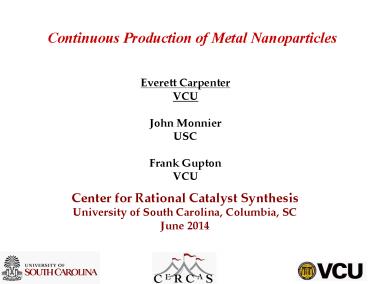Continuous Production of Metal Nanoparticles PowerPoint PPT Presentation
1 / 8
Title: Continuous Production of Metal Nanoparticles
1
Continuous Production of Metal Nanoparticles
Everett Carpenter VCU John Monnier USC Frank
Gupton VCU
Center for Rational Catalyst Synthesis University
of South Carolina, Columbia, SC June 2014
2
Research Team Everett Carpenter, John
Monnier, B. Frank Gupton Overview Utilize
continuous reactor technology for the production
of metal nanoparticles in order to increase both
the quantity and quality of these materials.
Continuous Production of Metal Nanoparticles
With and Without Microwave Irradiation
Technical Information We will use continuous
processing methods to explore the ability to
produce to produce bimetallic materials from
Group IB (Cu, Ag and Au) and Group VIII (Pd and
Pt) metal salts.
3
Industrial Relevance
- Although a significant effort has been made in
the characterization and application of these
materials, viable commercial manufacturing
methods for these materials remain a challenge.
The manufacturing processes for the production of
metal nanoparticles typically employs a batch
processing strategy in which metal salts are
chemically reduced to produce the metal
nanoparticles. There are several drawbacks with
this approach which include - Batch to batch variability of physical properties
and performance - Inability to produce large quantities of material
- Uncontrolled nucleation on heat transfer surfaces
- Lack of control of critical process parameters
- These barriers are further enhanced by using
conventional heating techniques that may pose
hazardous environmental and working conditions.
Such issues are significant to the commercial
production and therefore availability of metal
nanoparticles for industrial applications.
4
Goals of the Proposal
Use continuous reactor system to explore the
ability to produce bimetallic materials from
Group IB (Cu, Ag and Au) and Group VIII (Pd and
Pt) metal salts. We anticipate that this
approach will
- Achieve better control of metal nanoparticles
physical properties - Increase throughput of metal nanoparticle
manufacturing - Improve safety of and reduce exposure to
nanomaterials
5
Proposed Hypothesis
Continuous reactor technology can be applied to
the production of metal nanoparticles with and
without the use of microwaves, which will provide
a reproducible source of materials that can be
effectively controlled to meet specific
application requirements.
6
Research Methods/ Techniques
- Evaluate the effect of heating and flow rate
on particle size distribution - Factorial design of experiments
- Conventional Heating vs Microwave
- Determine valence state, metal dispersion and
particle size distribution - Measure exposed metal sites of bimetallic
materials by CO adsorption
7
Outcomes/ Deliverables
- Successful demonstration of continuous production
of metal nanoparticles - Control and characterization of particle size and
dispersion bimetallic species - CO adsorption in EtOH, H2O, and EtOH/H2O mixtures
on metal nanoparticles - Measurement of adsorption behavior (including
competitive adsorption) at different
concentrations and temperatures in order to
develop mechanistic models for these processes
8
Impact
- Demonstration of method for continuous production
of metal nanomaterials - Evaluation and charactorization of bimetallic
materials from Group IB (Cu, Ag and Au) and Group
VIII (Pd and Pt) metal salt. - Measurment of the exposed metal sites of the
bimetallic materials by CO adsorption
Duration of Project and Proposed Budget
- Two Years
- 60,000 Year 1
- 60,000 Year 2

